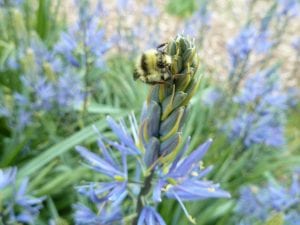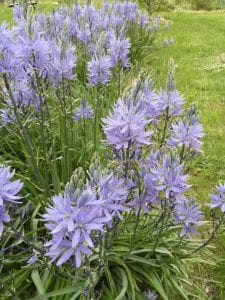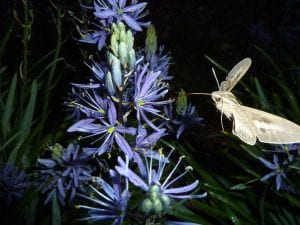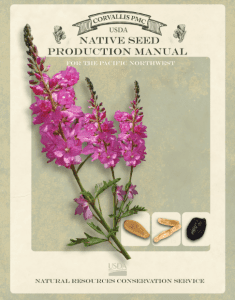Author: Klamath-Siskiyou Native Seeds
Creating Pollinator Habitat Class
Written by Klamath-Siskiyou Native Seeds on . Posted in Uncategorized.
2018 Native Plant Appreciation Week
Written by Klamath-Siskiyou Native Seeds on . Posted in Uncategorized.
Happy Earth Day!
Earth Day marks the end of California Native Plant Week and the beginning of Oregon Native Plant Appreciation Week, April 22-28, 2018. This week is for celebrating natural beauty while promoting a greater appreciation and knowledge of our local native plants, in order to highlight the importance of protecting and preserving these invaluable species.
Large camas (Camassia leichtlinii)
Written by Klamath-Siskiyou Native Seeds on . Posted in Uncategorized.
Flowering now!
Large camas (Camassia leichtlinii) is a spring-flowering bulbous perennial wildflower that is beautiful enough for the most high-end ornamental garden, yet adaptable and ecologically important enough to be included in habitat restoration projects within its range. Purple, lavender, or blueish-purple, star-shaped flowers open sequentially (bottom to top) in an upright terminal raceme, on thick stems that reach 2.5′-3.5′ tall. 2′ long, strap-shaped leaves rise from the clumping bulbs and wither after flowering. A lover of moist conditions, especially winter through late spring, large camas can dry out in the late summer months when the bulbs go dormant. In the wild, large camas is typically found growing in vernally moist meadows, grasslands, and on moist slopes or along rivers and streams. Tolerant of a wide variety of soil types, including clay, as long as there is adequate moisture in the spring. Camas provides valuable, early-season nectar and pollen for a variety of native pollinators. Camas was a staple food for many Native American tribes. The bulbs were harvested in the fall and either pit roasted or boiled and eaten, or dried and pounded into a flour.
Klamath-Siskiyou Native Seeds has large camas (Camassia leichtlinii) seed available. Check out our online shopping cart today!
Spring Garden Fair
Written by Klamath-Siskiyou Native Seeds on . Posted in Uncategorized.
Native Seed Germination Chart
Written by Klamath-Siskiyou Native Seeds on . Posted in Uncategorized.
Klamath-Siskiyou Native Seeds
Native Seed Germination Chart
(Click on the title to view and download the chart in Excel format.)
It can be difficult to find information regarding seed germination for native plant species. Through our own native plant propagation and growing experience, as well as long-term seed germination experimentation, we have developed a seed germination chart for species we often have in our inventory. This chart specifies the pretreatment needs for seed through cold-moist stratification (chilling requirements) or heat treatment, for natural or artificial seed germination, as well as recommendations for planting seed outside for natural seed germination. Germination rates can vary so your own personal experimentation is encouraged!
| Common Name | Botanical Name | Seed Germination Instructions |
| Vine maple | Acer circinatum | 30-60 days warm-moist stratification followed by 90-120 days cold-moist stratification. Sow outside in fall. |
| Common yarrow | Achillea millefolium | No pretreatment required. Sow in fall or spring on or just below the soil surface. Needs warm soil and light to germinate. |
| Vanillaleaf | Achlys triphylla | 60 days cold-moist stratification. Sow outside in fall to late winter. |
| Columbia monkshood | Aconitum columbianum | 60 days cold-moist stratification. Sow outside in fall to late winter. |
| Horse mint | Agastache urticifolia | 30-60 days cold-moist stratification. Sow outside in fall to late winter. |
| Western joepiweed | Ageratina occidentalis | No pretreatment required. Sow outside in fall to early spring. Germination may be improved with 30 days cold stratification |
| California dandelion | Agoseris grandiflora | No pretreatment required. Sow outside in fall to early spring. Germination may be improved with 30 days cold stratification. |
| Tapertip onion | Allium acuminatum | 30-60 days cold-moist stratification. Sow outside in fall to late winter. |
| Pacific mountain onion | Allium validum | 60-90 days cold-moist stratification. Sow outside in fall to late winter. |
| Menzies’ fiddleneck | Amsinckia menziesii | 60 days cold-moist stratification. Sow outside in fall for best germination. |
| Sharptooth angelica | Angelica arguta | 60 days cold-moist stratification. Sow outside in fall to late winter. |
| Woodland madia | Ansiocarpus madioides | 30-60 days cold-moist stratification. Sow outside in fall to late winter. |
| Western columbine | Aquilegia formosa | 60 days cold-moist stratification. Sow outside in fall to late winter. |
| California spikenard | Aralia californica | 90-120 days cold-moist stratification. Sow outside in fall for best germination. |
| Goat’s beard | Aruncus dioicus | 30-60 days cold-moist stratification. Sow outside in fall to late winter. Plant on soil surface or lightly cover. Seed needs light to germinate. |
| Heartleaf milkweed | Asclepias cordifolia | 60 days cold-moist stratification. Sow outside in fall to early spring. |
| Narrowleaf milkweed | Asclepias fascicularis | 60 days cold-moist stratification. Sow outside in fall to early spring. |
| Showy milkweed | Asclepias speciosa | 60 days cold-moist stratification. Sow outside in fall to early spring. |
| California harebell | Asyneuma prenanthoides | 60 days cold-moist stratification. Sow in fall to late winter. Sow on soil surface or lightly cover. Seed needs light to germinate. |
| Deltoid balsamroot | Balsamorhiza deltoidea | 90 days cold-moist stratification. Sow outside in fall. |
| Tall Oregon grape | Berberis (Mahonia) aquifolium | 90 days cold-moist stratification. Sow outside in fall to late winter. |
| Cascade Oregon grape | Berberis (Mahonia) nervosa | 60 days cold-moist stratification. Sow in fall to late winter. |
| California brome | Bromus carinatus | No pretreatment required. Sow outside in fall to early spring. |
| Chinook brome | Bromus laevipes | No pretreatment required. Sow outside in fall. |
| Tolmie’s cats ear | Calochortus tolmiei | 30-60 days cold-moist stratification. Sow in fall to late winter. |
| Marsh marigold | Caltha leptosepala | 60-90 days cold-moist stratification. Sow in fall to late winter. |
| Large camas | Camassia leichtlinii | 60-90 days cold-moist stratification. Sow in fall to late winter. |
| Deer brush | Ceanothus integerrimus | Soak in hot (not boiling) water for 24 hours, then 60-90 days cold-moist stratification. Sow outside in fall to late winter. |
| Birch leaf mountain mahogany | Cercocarpus betuloides | 60 days cold-moist stratification. Sow outside in fall to late winter. |
| Soaproot | Chlorogalum pomeridianum | No pretreatment required. Sow outside in fall to early spring. |
| Fireweed | Chamerion angustifolia | 60 days cold-moist stratification. Sow outside in fall to late winter. |
| Western redbud | Cercis occidentalis | Soak in hot (not boiling) water for 24 hours, then 60-90 days cold-moist stratification. Sow outside in fall to late winter. |
| Western clematis | Clematis ligusticifolia | 30-60 days cold-moist stratification. Sow outside in fall to late winter. |
| Hound’s tongue | Cynoglossum grande | 30-60 days cold-moist stratification. Sow outside in fall to late winter. |
| Mountain larkspur | Delphinium glaucum | 90-120 days cold-moist stratification. Sow outside in fall. |
| Meadow larkspur | Delphinium nuttallianum | 90-120 days cold-moist stratification. Sow outside in fall. |
| Henderson’s shooting star | Dodecatheon hendersonii | 60-90 days cold-moist stratification. Sow outside in fall to late winter. |
| Squirreltail grass | Elymus elymoides | No pretreatment required. Sow outside in fall to early spring. |
| Blue wildrye | Elymus glaucus | No pretreatment required. Sow outside in fall to early spring. |
| Capitate sandwort | Eremogone congesta | 60-90 days cold-moist stratification. Sow outside in fall to late winter. |
| Tall wooly buckwheat | Eriogonum elatum | 60 days cold-moist stratification. Sow outside in fall to late winter. |
| Arrowleaf buckwheat | Eriogonum compositum | 60 days cold-moist stratification. Sow outside in fall to late winter. |
| Barestem buckwheat | Eriogonum nudum | 60 days cold-moist stratification. Sow outside in fall to late winter. |
| Sulphur flower buckwheat | Eriogonum umbellatum | 60 days cold-moist stratification. Sow outside in fall to late winter. |
| Oregon sunshine | Eriophyllum lanatum | 30 days cold-moist stratification. Sow outside in fall to late winter. |
| Henderson’s fawn lily | Erythronium hendersonii | 90 days cold-moist stratification. Sow outside in fall. |
| Scarlet monkey flower | Erythranthe (Mimulus) cardinalis | No pretreatment required. Sow outside in fall to early spring. Seeds need light to germinate, surface sow. |
| Yellow seep monkey flower | Erythranthe (Mimulus) guttata | No pretreatment required. Sow outside in fall to early spring. Seeds need light to germinate, surface sow. |
| California poppy | Eschscholzia californica | 30 days cold-moist stratification. Sow outside in fall or early spring. |
| Western goldentop | Euthamia occidentalis | No pretreatment required. Sow outside in fall to early spring. |
| California fescue | Festuca californica | 30 days cold-moist stratification. Sow outside in fall or early spring. |
| Roemer’s fescue | Festuca roemeri | 30 days cold-moist stratification. Sow outside in fall or early spring. |
| Cascara | Frangula purshiana | 60-90 days cold-moist stratification. Sow in fall to late winter. |
| Bluehead gilia | Gilia capitata | 30 days cold-moist stratification. Sow outside in fall. |
| White rushlily | Hastingsia alba | 60-90 days cold-moist stratification. Sow outside in fall to late winter. |
| Bigelow’s sneezweed | Helenium bigelovii | 30 days cold-moist stratification. Sow outside in fall to late winter. |
| Cowparsnip | Heracleum maximum | 120 days cold-moist stratification. Sow outside in fall. |
| Alum root | Heuchera micrantha | 60 days cold-moist stratification. Sow outside in fall. Seeds need light to germinate, surface sow. |
| Oceanspray | Holodiscus discolor | 90-120 days cold-moist stratification. Sow outside in fall. |
| Broad leaved lotus | Hosackia crassifolia | Soak in hot (not boiling) water for 24 hours, then 60-90 days cold-moist stratification. Sow in fall to late winter. |
| Scarlet gilia | Ipomopsis aggregata | 30 days cold-moist stratification. Sow outside in fall to early spring. |
| Red beardtongue | Keckiella corymbosa | 30 days cold-moist stratification. Sow outside in fall or early spring. |
| Bush beardtongue | Keckiella lemmonii | 30 days cold-moist stratification. Sow outside in fall or early spring. |
| Bolander’s tarweed | Kyhosia bolanderi | 30-60 days cold-moist stratification. Sow outside in fall to late winter. |
| Siskiyou lewisia | Lewisia cotyledon | 30-60 days cold-moist stratification. Sow outside in fall to late winter. |
| Blue wild flax | Linum lewisii | 30 days cold-moist stratification. Sow outside in fall or early spring. |
| California lomatium | Lomatium californicum | 60 days cold-moist stratification. Sow outside in fall to late winter. |
| Fernleaf biscuitroot | Lomatium dissectum | 60 days cold-moist stratification. Sow outside in fall. |
| Bigseed biscuitroot | Lomatium macrocarpum | 60 days cold-moist stratification. Sow outside in fall to late winter. |
| Nineleaf buscuitroot | Lomatium triternatum | 60 days cold-moist stratification. Sow outside in fall to late winter. |
| Common lomatium | Lomatium utriculatum | 60 days cold-moist stratification. Sow outside in fall to late winter. |
| Pink honeysuckle | Lonicera hispidula | 60-90 days cold-moist stratification. Sow outside in fall. |
| Sickelkeel lupine | Lupinus albicaulis | Soak in hot (not boiling) water for 24 hours, then 30 days cold-moist stratification. Sow outside in fall to early spring. |
| Silver bush lupine | Lupinus albifrons | No pretreatment required. Sow outside in fall to early spring. |
| Velvet lupine | Lupinus leucophyllus | Soak in hot (not boiling) water for 24 hours, then 30 days cold-moist stratification. Sow outside in fall to early spring. |
| Elegant tarweed | Madia elegans | No pretreatment required. Sow outside in fall to early spring. |
| Large false Soloman’s seal | Maianthemum racemosum | Seed takes two years to germinate. Sow outside in fall. 6 months cold-moist stratification, followed by 4 months warm-moist stratification, followed by another 5 months cold-moist stratification. |
| Giant blazingstar | Mentzelia laevicaulis | 60-90 days cold-moist stratification. Sow outside in fall. |
| Coyote mint | Monardella odoratissima | 30 days cold-moist stratification. Sow outside in fall to late winter. |
| Coyote tobacco | Nicotiana attenuata | No pretreatment required. Sow outside, or start in a greenhouse in spring. |
| Indian tobacco | Nicotiana quadrivalvis | No pretreatment required. Sow outside, or start in a greenhouse in spring. |
| False turtlehead | Nothochelone nemorosa | 60-90 days cold-moist stratification. Sow outside in fall. |
| Douglas’ grasswidow | Olsynium douglasii | 90-120 days cold-moist stratification. Sow outside in fall. |
| Siskiyou Mountains owl’s clover | Orthocarpus cuspidatus | 90 days cold-moist stratification. Sow outside in fall. |
| Indian warrior | Pedicularis densiflora | 30 days cold-moist stratification. Sow in fall. Hemiparasite, needs host plant to thrive. Parasitic on members of the heath family, such as manzanita or madrone. |
| Siskiyou penstemon | Penstemon anguineus | 60-90 days cold-moist stratification. Sow outside in fall to late winter. |
| Hot rock penstemon | Penstemon deustus | 60-90 days cold-moist stratification. Sow outside in fall to late winter. |
| Mountain blue penstemon | Penstemon laetus | 60-90 days cold-moist stratification. Sow outside in fall to late winter. |
| Small flowered penstemon | Penstemon procerus | 60-90 days cold-moist stratification. Sow outside in fall to late winter. |
| Western sweet coltsfoot | Petasites frigidus | No pretreatment required. Sow outside in fall to early spring. |
| Varilieaf phacelia | Phacelia heterophylla | 30 days cold-moist stratification. Sow outside in fall or early spring. Seeds need light to germinate, surface sow. |
| Tall phacelia | Phacelia procera | 30 days cold-moist stratification. Sow outside in fall. Seeds need light to germinate, surface sow. |
| Mock orange | Philadelphus lewisii | 90-120 days cold-moist stratification. Sow outside in fall. |
| Pacific ninebark | Physocarpus capitatus | 30 days cold-moist stratification. Sow outside in fall or early spring. |
| Hooker’s fairybells | Prosartes hookeri | 60-90 days cold-moist stratification. Sow outside in fall. |
| Chokecherry | Prunus virginiana | 90-120 days cold-moist stratification. Sow outside in fall. |
| Bitter cherry | Prunus emarginata | 90-120 days cold-moist stratification. Sow outside in fall. |
| Golden currant | Ribes aureum | 90 days cold-moist stratification. Sow outside in fall. |
| Wax currant | Ribes cereum | 90-120 days cold-moist stratification. Sow outside in fall. |
| Sierra gooseberry | Ribes roezlii | 90-120 days cold-moist stratification. Sow outside in fall. |
| Sticky currant | Ribes viscosissimum | 90 days cold-moist stratification. Sow outside in fall. |
| Thimbleberry | Rubus parviflorus | 30 days cold-moist stratification. Sow outside in fall or early spring. |
| Waxy coneflower | Rudbeckia glaucescens | 30 days cold-moist stratification. Sow outside in fall or early spring. |
| Western coneflower | Rudbeckia occidentalis | 30 days cold-moist stratification. Sow outside in fall or early spring. |
| Blue elderberry | Sambucus nigra spp. caerulea | 60-90 days cold-moist stratification. Sow outside in fall. |
| Pacific blacksnakeroot | Sanicula crassicaulis | 30-60 days cold-moist stratification. Sow outside in fall or early spring. |
| Lambstongue ragwort | Senecio integerrimus | 30-60 days cold-moist stratification. Sow outside in fall to late winter. |
| Arrowleaf ragwort | Senecio triangularis | 30-60 days cold-moist stratification. Sow outside in fall or early spring. |
| Oregon checkermallow | Sidalcea oregana | 60-90 days cold-moist stratification. Sow outside in fall. |
| Bell catchfly | Silene campanulata | 30-60 days cold-moist stratification. Sow outside in fall to late winter. |
| West coast Canada goldenrod | Solidago elongata | No pretreatment required. Sow outside in fall to early spring. |
| Western mountain ash | Sorbus scopulina | 90-120 days cold-moist stratification. Sow outside in fall. |
| Douglas’ spiraea | Spiraea douglasii | 30-60 days cold-moist stratification. Sow outside in fall to late winter. |
| Subalpine spiraea | Spiraea splendens | 30-60 days cold-moist stratification. Sow outside in fall to late winter. |
| Lemmon’s needlegrass | Stipa lemmonii | 90 days cold-moist stratification. Sow outside in fall. |
| Claspleaf twistedstalk | Streptopus amplexifolius | Seed takes two years to germinate. Sow outside in fall. 6 months cold-moist stratification, followed by 4 months warm-moist stratification, followed by another 5 months cold-moist stratification. |
| Leafybract aster | Symphyotrichum foliaceum | No pretreatment required. Sow outside in fall to early spring. |
| Fringe cups | Tellima grandiflora | 30 days cold-moist stratification. Sow outside in fall or early spring. |
| Western false asphodel | Triantha occidentalis | 60-90 days cold-moist stratification. Sow outside in fall. |
| Vinegarweed | Trichostema lanceolatum | 60-90 days cold-moist stratification. Sow in fall to late winter. |
| California false hellebore | Veratrum californicum | 30-60 days warm-moist stratification followed by 90-120 days cold-moist stratification. Sow outside in early fall. |
| Western verbena | Verbena lasiostachys | 30-60 days cold-moist stratification. Sow outside in fall or early spring. |
| American vetch | Vicia americana | No pretreatment required. Sow outside in fall to early spring. |
| Narrowleaf mule’s ears | Wyethia angustifolia | 90 days cold-moist stratification. Sow outside in fall. |
| Beargrass | Xerophyllum tenax | 90-120 days cold-moist stratification. Sow outside in fall. |
Community Seed Swap
Written by Klamath-Siskiyou Native Seeds on . Posted in Uncategorized.
Native Seed Production Manual for the Pacific Northwest
Written by Klamath-Siskiyou Native Seeds on . Posted in Uncategorized.
Corvallis PMC Native Seed Production Manual for the Pacific Northwest
Looking for some detailed information on native seed propagation and plant propagation? This manual is a great resource. Although the manual is more focused on species that grow to the north of the Klamath-Siskiyou, there are still many native plants to our area included, and even having information on related species can be very helpful.
Klamath-Siskiyou Native Seeds is working hard to update our website to include more detailed plant information and seed germination instructions for all of the species we offer. Stay tuned, but for now, take a look at this manual for both information and inspiration!
To view the manual you can click on the title above or view and download from clicking here.
Sampson Creek Preserve Seed Collection and Native Planting
Written by Klamath-Siskiyou Native Seeds on . Posted in Uncategorized.
Planting and seeding in the prescribed burn area in upland grassland and oak savanna habitat at the Sampson Creek Preserve.
In November Klamath-Siskiyou Native Seeds (KSNS) took part in a major native planting project for monarch butterfly habitat on the Sampson Creek Preserve outside Ashland, OR, near Emigrant Lake. The Sampson Creek Preserve is managed by the Selberg Institute as a nature preserve that encompasses nearly 4,800 acres of undeveloped grasslands, woodlands and forest. The preserve was a former cattle ranch and long-term cattle grazing has had an impact on the herbaceous native plant community in what is otherwise a stunningly beautiful and highly valuable habitat that borders the Cascade-Siskiyou National Monument. The Selberg Institute is taking steps to combat invasive species and restore the native plant diversity on the preserve.
Planting native plants for monarch butterfly habitat in the riparian area at the Sampson Creek Preserve.
The Sampson Creek Preserve planting is part of a larger project partially funded by a $193,786 grant from the National Fish and Wildlife Foundation’s Monarch Butterfly Conservation Fund. A coalition that included the Selberg Institute, Southern Oregon Monarch Advocates, US Fish and Wildlife Service, Forest Service, BLM, and Lomakatsi Restoration Project secured the grant in order to do restoration work on a wide variety of sites in southwest Oregon, and across a large geographic area. Sites include Forest Service land in Agness, BLM/TNC land on Table Rocks, Forest Service land in Butte Falls, private land in the Colstein Valley and Ashland areas, as well as the Sampson Creek Preserve. This landscape-scale project is likely the largest effort to restore western monarch butterfly habitat in the West.
Planting native milkweed and other native herbaceous plants into the prescribed burn area at the Sampson Creek Preserve.
The overall goal of the project is to restore monarch butterfly habitat on 300 acres in southwest Oregon. The Sampson Creek Preserve portion of the project includes 40 acres of restoration within riparian habitat as well as upland, grassland habitat with an oak savanna component. Twenty acres of the grassland and oak savanna had a prescribed burn in the fall prior to planting and seeding. With help from KSNS, Southern Oregon Monarch Advocates (SOMA) and the Selberg Institute designed and implemented the planting and seeding at the Sampson Creek Preserve.
The planting at the Sampson Creek Preserve included a wide-variety of community partners, organizations, and volunteers: Pollinator Project Rogue Valley, Southern Oregon University students, SOMA, BLM botany interns, KSNS, the Selberg Institute, local monarch and pollinator advocates, and retired BLM and Forest Service staff, all pulled together to make it happen!
Maia Black, Executive Director of the Selberg Institute, mixing and planting seeds collected by Klamath-Siskiyou Native Seeds in the prescribed burn area.
Custom, site-specific seed mixing of native seeds collected at the Sampson Creek Preserve for seeding into the prescribed burn area.
Over the last two years KSNS has collected seed from various habitat types at Sampson Creek Preserve for growing out nursery stock and direct seeding. We collected seeds from 48 native species in 2017. See the full list here: 2017 SCP Seed Collection List
We took care to collect ethical amounts of seed from various collection locations on the Preserve to ensure the long-term viability of existing native plant populations. We collected, dried, and cleaned the seed, returning the seed to the Selberg Institute for the current monarch butterfly restoration work, and future restoration needs. It is important for local, genetically appropriate, site-specific native plant seed to be used for habitat restoration to ensure genetic diversity and local adaptation. We commend the Selberg Institute for their commitment to using local native plant seeds for their projects.
Over 7,000 native plants were planted for monarch butterfly habitat at the Sampson Creek Preserve, with a good portion of the seed used for the nursery-grown plants collected on-site at the preserve by Klamath-Siskiyou Native Seeds. The majority of the plants were milkweed for monarch caterpillars, but there was also a large, diverse selection of native nectar plants for adult monarchs planted as well. This work will benefit monarchs, but it will also benefit many other species of pollinator and wildlife at the preserve.
Oregon sunshine (Eriophyllum lanatum), Tolmie’s cat’s ear (Calochortus tolmiei), Harvest brodiaea (Brodiaea elegans) seed collected at the Sampson Creek Preserve by Klamath-Siskiyou Native Seeds.
If you are interested in contracting Klamath-Siskiyou Native Seeds seed collection services for a project, please contact us early, as our summer seed collection season fills up fast!
Give the Gift of Native Wildflowers!
Written by Klamath-Siskiyou Native Seeds on . Posted in Uncategorized.








































